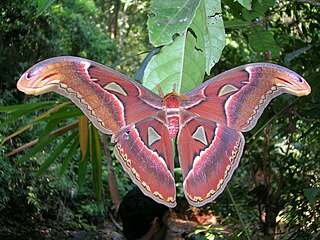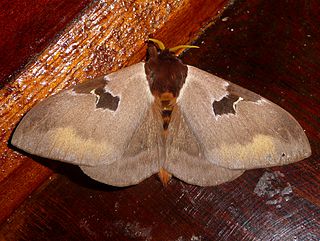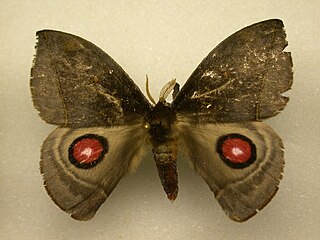Related Research Articles

Saturniidae, members of which are commonly named the saturniids, is a family of Lepidoptera with an estimated 2,300 described species. The family contains some of the largest species of moths in the world. Notable members include the emperor moths, royal moths, and giant silk moths.

Saturnia pavonia, the small emperor moth, is a moth of the family Saturniidae. It was first described by Carl Linnaeus in his 1758 10th edition of Systema Naturae. Sometimes, the incorrect genus name Pavonia is still used for this species. This moth occurs throughout the Palearctic region and is the only member of its family to be found in the British Isles, where it is usually called simply the emperor moth.

Saturnia is a genus of large silkmoths in the family Saturniidae, which the German biologist Franz von Paula Schrank first described in 1802. Its members are commonly named emperor moths, though this is also used for various close relatives in subfamily Saturniinae. Most species are Palearctic, but three, commonly called "saturnia moths", inhabit the chaparral of California: S. mendocino, S. walterorum, and S. albofasciata.

The dryandra moth is a species of moth that is considered to be the sole member of the family Carthaeidae. Its closest relatives are the Saturniidae and it bears a resemblance to many species of that family, bearing prominent eyespots on all wings. The common name is derived from the Dryandra shrubs of the genus Banksia, on which the larva of this species feed, and is hence restricted to the south-west of Western Australia where these shrubs grow. Other Grevillea shrubs may also be used as host plants.

Actias ningpoana, the Chinese moon moth, is a species of moth in the family Saturniidae. The species was first described by father-and-son entomologists Cajetan and Rudolf Felder in 1862. It is quite large, and has long, curved, hindwing tails. There are many congeners across Asia; the Luna moth of eastern Canada and the United States is a close relative.

The Saturniinae or saturniines are a subfamily of the family Saturniidae, also known as giant silkmoths. They are commonly known as emperor moths or wild silk moths. They are easily spotted by the eyespots on the upper surface of their wings. Some exhibit realistic eye-like markings, whilst others have adapted the eyespots to form crescent moon or angular shapes or have lost their wing scales to create transparent windows. They are medium to very large moths, with adult wingspans ranging from 7.5 to 15 cm, in some cases even more. They consist of some of the largest sized Lepidoptera, such as the luna moth, atlas moth, and many more. The Saturniinae is an important source of wild silk and human food in many different cultures.

Arsenura armida, the giant silk moth, is a moth of the family Saturniidae. It is found mainly in South and Central America, from Mexico to Bolivia, and Ecuador to south-eastern Brazil. It was first described by Pieter Cramer in 1779.

Antherina is a monotypic moth genus in the family Saturniidae erected by William Elford Leach in 1815. Its only species, Antherina suraka, the Suraka silk moth, was first described by Jean Baptiste Boisduval in 1833. It is found on Madagascar and Mayotte. Both larvae and pupae consumed in parts of Madagascar, but not to a great extent. The larvae feed on oleander, privet, willows, beech, Liquidambar, Crataegus (hawthorns), grapevine, lilac, cherry, laurel, Forsythia, Rhus, Pistacia, apple, pear, plum and peach leaves, but foodplants differ from species to species. They start off black with yellow protrusions to eventually green with red and yellow on their bodies. Once they've finished growing they will be as thick as your finger and when they have reached their final days as a caterpillar they will develop a blue dorsal stripe and wander around looking for a place to pupate.

Perisomena is a genus of moths in the family Saturniidae.

Attacus is a genus of moths in the family Saturniidae. The genus was named by Carl Linnaeus in his 1767 12th edition of Systema Naturae.
Attacus wardi is a moth from the family Saturniidae endemic to Northern Territory, Australia, historically classified as a subspecies of Attacus dohertyi.
Cercophana is a genus of moths in the family Saturniidae first described by Cajetan Felder in 1862.

Dirphia is a genus of moths in the family Saturniidae first described by Jacob Hübner in 1819.

Gamelia is a genus of moths in the family Saturniidae first described by Jacob Hübner in 1819.
Leucanella is a genus of moths in the family Saturniidae first described by Claude Lemaire in 1969.

Paradirphia is a genus of moths in the family Saturniidae first described by Charles Duncan Michener in 1949.
Homoeopteryx is a genus of moths in the family Saturniidae first described by Felder in 1874.

Citheronia laocoon is a species of moth in the family Saturniidae. It is found from the Guianas south to northern Argentina.

Usta is a genus of moths in the family Saturniidae first described by Hans Daniel Johan Wallengren in 1863.
References
- ↑ "Gattung: Eochroa" [Genus: Eochroa]. Saturniidae World Homepage für den Saturniidenfreund (in German). Archived from the original on July 19, 2011. Retrieved May 26, 2010.